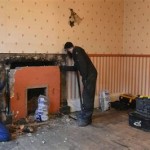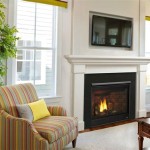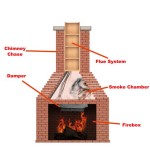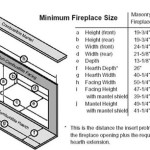```html
Build Fireplace Mantel Over Brick
A fireplace mantel serves as both a decorative focal point and a functional shelf above a fireplace. Installing a mantel over an existing brick fireplace can significantly enhance the aesthetic appeal of a room. This process requires careful planning, precise measurements, and the use of appropriate materials to ensure a secure and visually pleasing result. The following article outlines the steps involved in building a fireplace mantel over brick, providing detailed guidance on material selection, installation techniques, and safety considerations.
Before beginning the project, a thorough assessment of the existing brick fireplace is crucial. The condition of the brick, its dimensions, and the overall style of the room will influence the design and installation method of the mantel. It is essential to determine whether the brick is structurally sound and capable of supporting the weight of the mantel. Any loose or damaged bricks should be repaired or replaced prior to installation.
Key Considerations Before Starting
Several key factors must be taken into account before commencing the mantel installation. First, adherence to local building codes and regulations concerning fireplace mantels is imperative. These regulations typically address fire safety standards, including the minimum clearance between the mantel and the firebox opening. Failing to comply with these regulations can result in safety hazards and potential code violations.
Second, the design of the mantel should complement the existing architecture of the room. Consider the style of the house, the existing trim work, and the overall color scheme when selecting the mantel's design. A well-designed mantel will seamlessly integrate into the room's decor, enhancing its aesthetic appeal.
Finally, the weight of the mantel must be carefully considered. Heavier mantels will require more robust support and installation techniques. If the mantel is particularly heavy, it may be necessary to consult with a structural engineer to ensure that the brick fireplace can safely support the load. It is prudent to overestimate the weight capacity needed to account for any future additions or decorations placed on the mantel.
The selection of materials is a critical step in the process. Various types of wood, such as pine, oak, and maple, are commonly used for mantels. The choice of wood will depend on the desired aesthetic, the budget, and the level of durability required. For a rustic look, reclaimed wood can be an excellent option. Alternatively, manufactured materials, such as medium-density fiberboard (MDF) or faux wood, can provide a more cost-effective and consistent alternative.
In addition to the mantel itself, other necessary materials include construction adhesive, masonry screws, shims, and finishing supplies such as paint, stain, and sealant. The type of construction adhesive should be specifically formulated for bonding to masonry to ensure a strong and durable connection. Masonry screws are designed to anchor into brick and provide a secure mechanical connection. Shims are used to level the mantel and ensure a flush fit against the brick surface. Finishing supplies are used to protect the wood and enhance its appearance.
Step-by-Step Installation Process
The installation process begins with precise measurements. The width and height of the fireplace opening should be measured accurately to determine the required dimensions of the mantel. It is also important to measure the depth of the mantel to ensure that it will not project excessively into the room. A level should be used to ensure that the mantel will be installed horizontally.
Once the measurements have been taken, the mantel can be prepared for installation. This may involve cutting the wood to the desired dimensions, sanding it smooth, and applying any necessary finishing treatments. If using a pre-fabricated mantel, ensure that it is properly assembled according to the manufacturer's instructions.
The next step involves applying construction adhesive to the back of the mantel. A generous amount of adhesive should be applied to ensure a strong bond with the brick. It is crucial to use an adhesive that is compatible with both wood and masonry. The adhesive should be applied in a serpentine pattern to maximize surface area contact.
With the adhesive applied, carefully position the mantel against the brick fireplace. Use shims to level the mantel and ensure that it is flush against the brick surface. Hold the mantel in place for several minutes to allow the adhesive to begin to set.
After the adhesive has partially cured, masonry screws should be used to provide additional support. Drill pilot holes through the mantel and into the brick using a masonry drill bit. Insert masonry screws through the pilot holes and tighten them securely. The number of screws required will depend on the size and weight of the mantel. Ensure that the screws are long enough to penetrate deep into the brick and provide a strong anchor.
Once the mantel is securely attached, allow the adhesive to fully cure according to the manufacturer's instructions. This may take several hours or even overnight. During this time, avoid placing any weight on the mantel to prevent it from shifting or becoming dislodged.
After the adhesive has fully cured, the shims can be removed. Any gaps between the mantel and the brick can be filled with caulk or wood filler. Sand the caulk or wood filler smooth and apply a final coat of paint or stain to blend it seamlessly with the surrounding surface.
Safety and Finishing Touches
Fire safety is paramount when installing a fireplace mantel. As previously mentioned, adherence to local building codes regarding clearance requirements is essential. The mantel should be positioned at a safe distance from the firebox opening to prevent it from catching fire. A non-combustible barrier, such as a sheet of metal or cement board, can be installed behind the mantel to provide additional protection.
The finishing touches can significantly enhance the appearance of the mantel. Decorative trim, such as crown molding or fluted pilasters, can be added to complement the style of the room. Consider adding a decorative hearth below the fireplace to create a more cohesive and visually appealing focal point.
Regular maintenance is essential to keep the fireplace mantel in good condition. Dust the mantel regularly and clean it with a mild soap and water solution. Avoid using harsh chemicals or abrasive cleaners, as these can damage the finish. Inspect the mantel periodically for any signs of damage, such as cracks or loose screws. Repair any damage promptly to prevent it from worsening.
Building a fireplace mantel over brick is a project that can significantly enhance the aesthetic appeal of a room. By following these detailed instructions and taking appropriate safety precautions, homeowners can successfully install a mantel that is both beautiful and functional. The result is a stunning focal point that adds character and warmth to the home.
```
Easy Fireplace Mantel Diy

Easy Fireplace Mantel Diy

Fireplace Makeover The Lettered Cottage Diy Remodel

Diy Rustic Fireplace Mantel The Cure For A Boring

How To Install A Mantel On Brick Fireplace 1905 Farmhouse

How To Make A Diy Fireplace Mantel The Idea Room

The Making Of A Slip Covered Mantel Made By Carli

How To Make A Diy Fireplace Mantel The Idea Room Remodel Makeover

The Handcrafted Life Finale To Building A Fireplace Facade Covering Brick Adding Shelves Cabinet And Trim Painting

How To Make A Diy Fireplace Mantel The Idea Room
Related Posts








